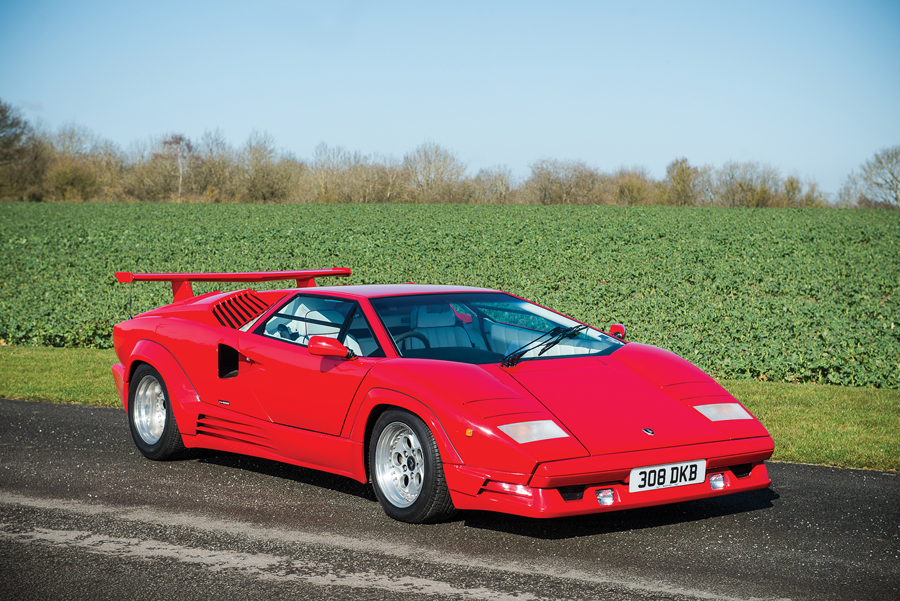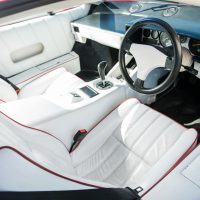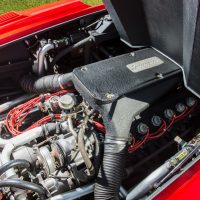SCM Analysis
Detailing
| Vehicle: | 1989 Lamborghini Countach 25th Anniversary |
| Years Produced: | 1989 |
| Number Produced: | 657 |
| Original List Price: | $145,000 MSRP |
| SCM Valuation: | Median price to date, $358,900; high sale, $451,000 |
| Tune Up Cost: | $2,000–$3,000 |
| Chassis Number Location: | Stamped on frame in engine bay |
| Engine Number Location: | Between cylinder heads |
| Club Info: | Lamborghini Club of America |
| Website: | http://www.lamborghiniclubamerica.com |
| Alternatives: | 1987–91 Ferrari Testarossa, 1978–80 BMW M1, 2005 Ford GT |
| Investment Grade: | B |
This car, Lot 344, sold for $352,378, including buyer’s premium, at Silverstone’s The May Sale on May 20, 2016, at the Silverstone Circuit, Northamptonshire, U.K.
To drive the Countach is to hate it, but to look at it is to love it. It’s claustrophobic, hot, ergonomically impossible and handles poorly.
But with its raked, muscular, cab-forward form, the Countach is among the most iconic and recognizable car designs of all time — and that fact has driven its parabolic rise in value. The 1989–90 25th Anniversary edition is riding the wave of a sharp increase in price of the 1974–76 Countach Periscopio cars, which have skyrocketed in the past few years.
In 2014, the LP400 Periscopio appreciated more than any other collector car.
That year, an early example crossed the block at over $1 million for the first time. Other examples followed, selling near the $2 million mark. The 25th Anniversary Countach has also sharply appreciated, although it started at a much lower baseline.
Long considered less desirable than its earlier, purer and far more rare wingless sibling, the Anniversary Edition is firmly moving into collector-car status. Five years ago, these cars could be bought for under $100,000. Now they’re selling for between $300,000 and $500,000. Ultra-low-mileage examples have reportedly traded in the private market for even more.
These valuations are emotionally driven. Despite its quirks when it comes to comfortably driving the car, there’s a reason the Countach’s image adorned the walls of so many teenagers’ bedrooms and undergraduate dorm rooms across America — right alongside posters of Heather Thomas and Christie Brinkley.
Aesthetically, the Countach is the essence of supercar. The name Countach, from the northern Italian Piedmontese dialect, is an exclamation of desire.
According to folklore, Italian designer Giuseppe Bertone said, “Countach!” when he saw an early prototype of Marcello Gandini’s groundbreaking, bold design. The car’s styling is full of contradictions: It’s angular and curvy, sumptuous and stark, masculine and feminine. And yet these seemingly disparate elements come together to form a perfect visual union.
The boys who coveted the Countach in the 1970s and 1980s are now of the age and means to pay up in the collector market.
The 25th Anniversary edition is laden with flamboyant style add-ons that reflect the excess of the 1980s. But this version of the car does have better build quality than its earlier siblings.
In 1987, Chrysler purchased Lamborghini and infused much-needed cash. The final edition of the Countach has upgrades overseen by legendary race driver Sandro Munari, including power windows, wider power seats, semi-functional air conditioning, liberal use of new composite materials, larger Pirelli P Zero tires, and new OZ rims. It reaches 0–60 mph in 4.3 seconds and tops out at 185 miles per hour. The car also has bodywork enhancements that many consider overdone: “ground-effects,” larger vents and intakes — and the optional gaudy and functionless wing.
Overall, the Countach has three qualities that will continue to drive its emotional value on the collector market: It’s rare, it’s recognizable, and it’s a rule-breaker.
It’s rare enough
Just about 2,000 Countaches were built from 1974 to 1990. The car went through several iterations during its production, and each series is unique. Only about 110 LP400 Periscopios were made, while 657 25th Anniversary cars were produced. The 25th Anniversary car’s numbers push it into the not-as-rare category, but it’s still rare enough to be highly collectible.
It’s instantly recognizable
The Countach’s iconic shape and cab-forward design make it instantly recognizable. There’s no other car like it. The radical, raked hood line continues straight into the windshield. The windows lean steeply into the roof.
The sharp front bumper and slim nose have an almost feminine air, while the muscular, tall, and massive rear end screams masculinity. The forward-facing rear wheelwell gives the car an aggressive and downward stance. A beautiful, sculpted door line and gaping NACA air-intake duct unite the lean hood line and brawny haunches. And the Countach sports those infinitely cool scissor doors. In the history of cars, only the Model T and the VW Beetle are as universally familiar. But unlike those two cars, the Countach makes a statement of power, sexuality and extravagance.
It’s a rule-breaker
The Countach throws Louis Sullivan’s form-follows-fuction rule out the window. The car is a purely aesthetic creation. I’ve never read one single positive driving review of the Countach.
To start, it’s a herculean effort to vault over the massive doorsills and into the car. Then there are the seats, which combine the worst qualities of a bucket and a bear trap.
The car has zero rearward visibility; you can’t back it up with any confidence unless you hang out the open scissor door or install an aftermarket back-up camera. Get out on the road, and the ride is jarring, the steering unresponsive, and the handling unremarkable.
The only impressive feature of this supercar’s performance is its straight-line acceleration. This is not a car to drive and enjoy. It’s a car to worship and admire. The V12 doesn’t need to run to get your motor running; it doesn’t need to move to move you. When you buy a Countach, you’re buying a style icon.
A green future
The swansong edition of the Countach is the most well built and advanced of all Countach models. While the market prefers the clean and pure shape of the original wingless and narrow-tire LP400 over the bloated and cluttered “Gordon Gekko” look of the Anniversary edition, the final version of the car still maintains its unmistakable character.
Although Anniversary Countaches could take a pause here — or even decline for a period of time with the broader market — the future appreciation prospects for the Anniversary cars are strong, and looking out 10 or 20 years, I see only green.
At least two 25th Anniversary cars are scheduled to sell at auctions on the Monterey Peninsula this August. Despite the general cooling off of the collector car market, I expect the bidding to be strong for these cars. ♦
(Introductory description courtesy of Silverstone Auctions.)





